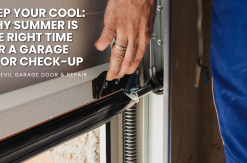
If you are tired of looking at a faded, stained or rusty garage door every time you arrive home, you’re certainly not alone as can be evidenced by the many do-it-yourself ideas on Pinterest for garage doors. If you would like to update the appearance of your door, leaving it looking like the day it was first installed (if not better), then this garage door staining guide is a must read!
Tools You’ll Need:
- Degreaser (409)
- High-quality paintbrushes (2 to 3 inches)
- High-quality paint rollers (4 to 6 inches)
- Clean one-gallon bucket
- Paint tray
- Roll of painter’s tape
- Disposable rubber gloves
- Disposable rags and/or paper towels
Step #1: Selecting a Stain
Visit any local home improvement, hardware or paint supply store, and you should be able to find a high-quality stain for exterior use in the color you’re looking for. It’s recommended you use a gel stain, which goes on thick and sits on the surface of your door, rather than a traditional stain. Gel stain also won’t hide your door’s natural grain. You can find gel stains in a wide variety of colors, like cheery, for example. Purchase stains in a matte finish; gloss is not recommended.
Step #2: Preparation
This is the key to success. Depending on the current condition of your garage door, you may want to do a little sanding to remove any superficial rust or peeling paint, therefore ensuring the new stain adheres properly. Next, you’ll want to thoroughly spray the door with a degreaser, cleaning off any lingering dirt or debris with a clean rag. Rinse the door using a pressure washer at the lowest setting. Once dry, use painter’s tape to mask any decorative handles, trim or windows.
Step #3: Priming
To promote adhesion and durability, as well as get the finished color you’re looking for use a high-quality, exterior primer. If you live in an area prone to wet conditions, where rust occurs more often than not, we recommend using a rust-proof primer. After priming and before proceeding with the stain, you’ll want to make sure the door is completely, 100% dry. You’ll also want to lay a tarp or some cardboard down to protect your driveway from drips and spills.
Step #4: Staining
Start at the top. Using a high-quality brush, stain the recessed areas, working your way down from the top. Use a roller on flat surfaces. You can then create a woodgrain finish with your brush using decorative paint technique called “strie” also known as “dragging.” For direction, click here. Allow the door to dry completely. This usually takes 12 hours, but may take up to 48 hours, depending on your area’s climate.
Step #5: Cleaning Up
Although this step may seem like a pain, it will save you from having to redo your work, as well as having to purchase all new supplies. Once you’re done staining, it’s a good idea to thoroughly rinse your paintbrushes, rollers, and all other reusable supplies in water until the water runs clear. Store brushes by hanging them upside down on hooks. Remove painter’s tape at a 45-degree angle to avoid removing any stain.
Damaged Door? Consider a New Garage Door!
If your door is damaged, staining unfortunately isn’t going to help, and you may want to consider investing in a new garage door. There are many advantages to new garage doors including increases in safety, security, curb appeal, and property values. At Sun Devil Garage Door, we offer our customers one of largest selections of new garage doors in their choice of finish and style. Contact us today for more information.



